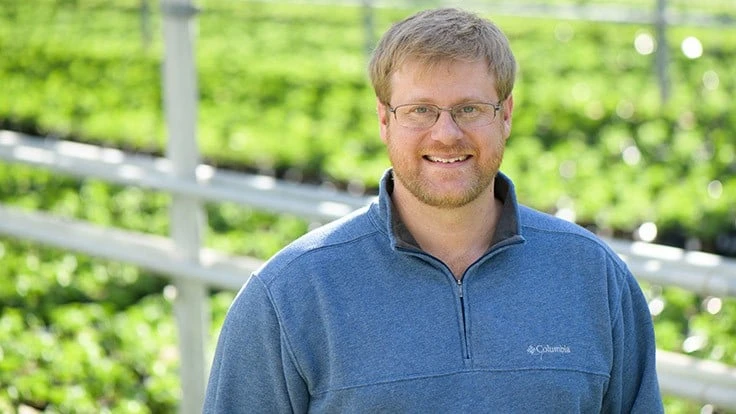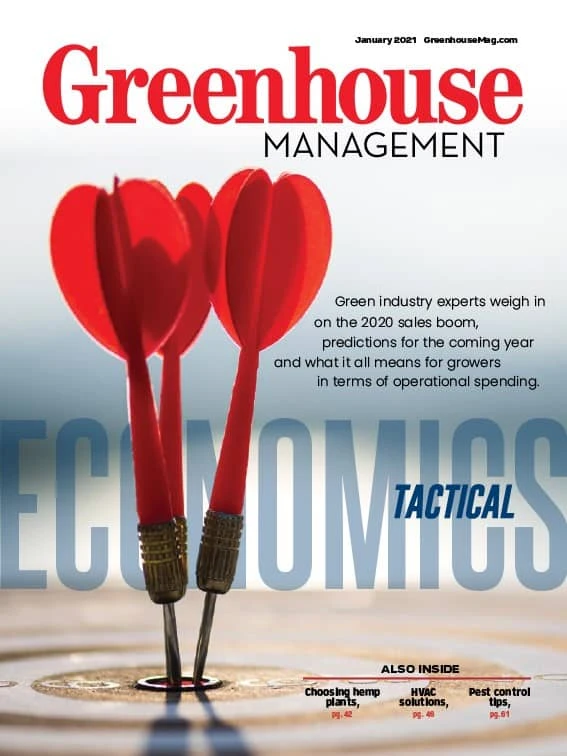

Growing up in the greenhouse, Brian Austin has always been surrounded by plants. By age 6, he was pulling weeds for his dad, who worked as a head grower for many years.
“I had a fascination with plants from a young age,” Austin says. “I loved going into the greenhouse and helping my dad with little jobs on the weekends.”
When his dad opened his own wholesale operation, The Garden Path Greenhouse, in the late 90s, Austin gained experience in various aspects of the business, from planting to watering to driving trucks. To complement his informal growing experience, Austin pursued a Bachelor of Science in Horticulture and Landscape Architecture from Colorado State University, with concentrations in floriculture and nursery management.
“Being exposed to the science of how and why plants grow renewed my passion,” says Austin, who managed the CSU trail garden for a couple seasons. “I fell in love with growing.”
During his last semester of college, Austin started working weekends at Dutch Heritage Gardens in Larkspur, Colorado, located just south of Denver. When he graduated in May 2009, he joined the business full-time as an assistant grower. Then, in 2015, he was promoted to head grower. Now, Austin focuses on finding new ways to improve plant production by empowering his team to innovate.

Learning from new crops
Since 2006, Dutch Heritage Gardens has been producing high-quality bedding plants and potted crops for grocery chains like Kroger. In 2016, the Colorado-based operation recognized a new opportunity to grow young hemp plants for large farms.
“We already had the processes and infrastructure in place to produce large volumes of young plants because we do our own propagation of petunias and geraniums,” Austin says. “There wasn’t a good supply from people growing hemp out of garages and indoor spaces, so it was a natural fit to become a young hemp supplier.”
Austin assumed the transition to hemp would be as easy as growing petunias, but instead he encountered some unexpected rooting challenges.
“We buy all our annual cuttings from big farms, but with hemp, we have to grow the stock plants and then take the cuttings, so we had to set those cuttings up for success,” he says. “Some practices we’ve done to improve our hemp cutting quality include dipping them in certain formulations of rosemary oil, fertilizers and different concentrations of IBA rooting hormone.”
After seeing success with dipped hemp cuttings, Austin’s team began trialing dips for other crops like lotus and poinsettia, while also implementing new sanitation protocols across the operation to ensure plant cleanliness.
By 2019, hemp filled about a quarter of the 9-acre greenhouse facility. “We couldn’t grow enough hemp,” Austin says. “The market was hot.” In 2020, Dutch Heritage increased hemp production to a 50/50 split with its bedding plants. This spring, the company will add another 5 acres of greenhouse space to increase its capacity for both types of crops.

Encouraging new ideas
To maximize limited resources, Austin constantly explores ways to improve efficiencies at Dutch Heritage Gardens.
For example, he developed a program to stick unrooted cuttings directly into final containers — eliminating transplanting without affecting the rooting percentage (which improved in some cases). “That saved us 20% in labor during the spring, which is huge, because our location is so remote that it’s a challenge to get labor here,” he says.
To make the most of the labor he has, Austin taps into his team’s ideas for improving the operation. He regularly walks each section of the greenhouse one-on-one with his two assistant growers and three section growers, giving them the opportunity to propose solutions to the crop issues they’re reporting.
“I don’t want to be the only idea source here. I want them to come up with their own ideas, and know how to go about trialing it to see how it works,” Austin says. “Having the assistant growers conduct the trials gives them a higher sense of purpose. If their trial works out and we implement it into our growing method, they feel like they’ve contributed value — which they have.”
One of his growers is currently trialing different surfactants on poinsettia bracts to find a rate high enough to clean off water spots without causing phytotoxicity. Through these experiments, Austin empowers his team to discover process improvements.
“I’m not just giving orders, but guiding them to make their own educated growing decisions,” he says. “The more they learn, the more they grow; then the more we grow as a team.”
As much as Austin enjoys plants, being a head grower has taught him that cultivating people can be even more fulfilling than growing flowers.
“People take a personal investment of time and emotion, which obviously can be challenging — but that’s also the most rewarding thing (about being a head grower), is seeing people grow and succeed,” he says.

Explore the January 2021 Issue
Check out more from this issue and find your next story to read.
Latest from Greenhouse Management
- Anthura acquires Bromelia assets from Corn. Bak in Netherlands
- Top 10 stories for National Poinsettia Day
- Langendoen Mechanical hosts open house to showcase new greenhouse build
- Conor Foy joins EHR's national sales team
- Pantone announces its 2026 Color of the Year
- Syngenta granted federal registration for Trefinti nematicide/fungicide in ornamental market
- A legacy of influence
- HILA 2025 video highlights: John Gaydos of Proven Winners





